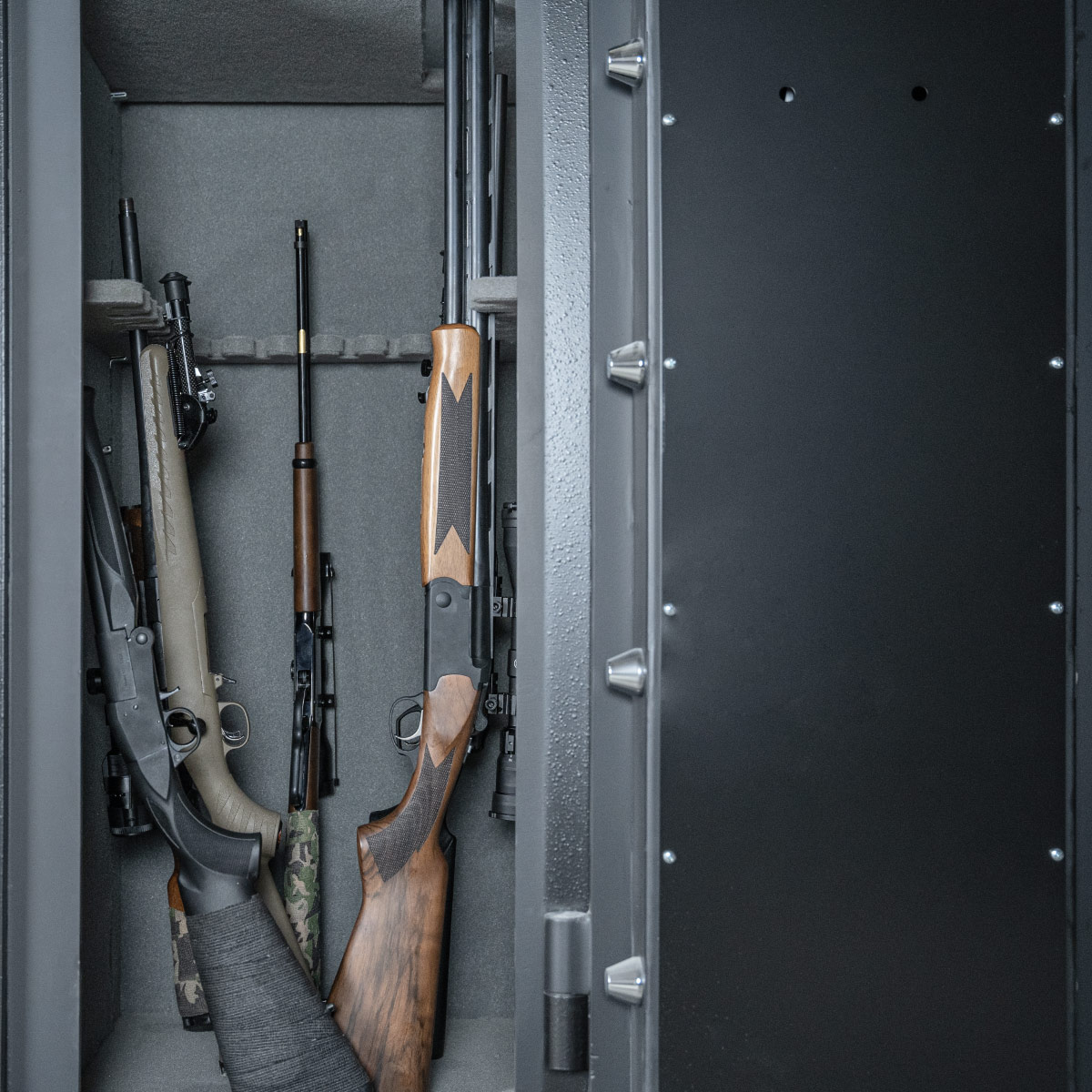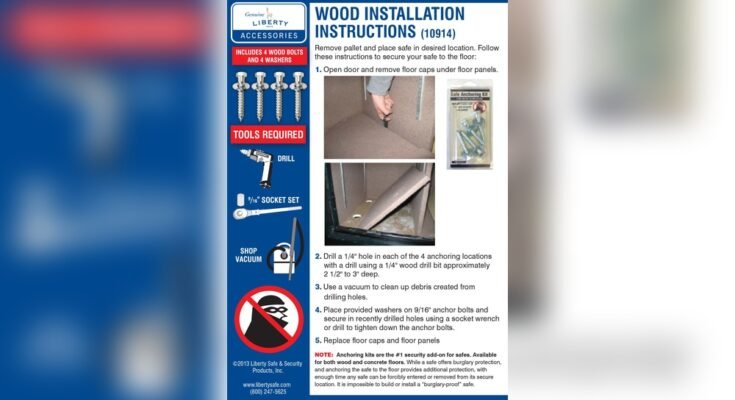Are you wondering if your gun cabinet really needs to be anchored? You might think it’s safe just standing there, but without proper anchoring, it could tip over or be easily moved by someone else.
This small step could make a big difference in keeping your firearms secure and your home safe. Keep reading to discover why anchoring your gun cabinet is more important than you might realize—and how it can protect what matters most to you.
Why Anchoring Matters
Anchoring gun cabinets is a crucial step for safety and security. It ensures your cabinet stays firmly in place. Without anchoring, the cabinet can tip over or be moved easily. This can put your firearms at risk and cause accidents. Anchoring protects your investment and keeps everyone safer. The reasons for anchoring go beyond just stability.
Preventing Tip-overs
Gun cabinets can be heavy but unstable on smooth floors. A slight push or uneven surface may cause a cabinet to fall. Anchoring secures the cabinet to a wall or floor. This stops it from tipping over during an earthquake or accidental bump. Preventing tip-overs protects both your guns and family members. It reduces the chance of injuries caused by falling cabinets.
Enhancing Security
Anchoring adds an extra layer of security to your gun cabinet. It makes the cabinet harder to move or steal. Burglars or intruders face more difficulty if the cabinet is fixed in place. This slows down theft attempts and protects your firearms. A secured cabinet keeps guns away from unauthorized users or children. It improves overall safety in your home.
Complying With Regulations
Many local laws require gun cabinets to be anchored. These rules aim to keep firearms out of reach from unauthorized persons. Anchoring is often part of legal gun storage standards. Following these regulations helps you avoid fines or penalties. It also shows responsible gun ownership. Checking local laws ensures your gun cabinet meets safety requirements.
Types Of Gun Cabinets
Gun cabinets come in different types to fit various needs and spaces. Each type offers unique features for storing firearms safely. Understanding these types helps you choose the best option for your home or office.
Some gun cabinets are fixed to walls, while others stand freely on the floor. There are also small, portable options for easy transport and quick access. Each design has its benefits and security levels.
Wall-mounted Cabinets
Wall-mounted cabinets attach directly to a wall for extra security. They save floor space and keep guns out of reach of children. These cabinets often require strong anchors to hold their weight safely. They are ideal for small rooms or apartments with limited space.
Freestanding Cabinets
Freestanding cabinets stand on the floor and offer more storage space. They can hold multiple firearms and other valuables. These cabinets are heavier and bulkier, making them harder to move. Anchoring them to the floor or wall improves security and prevents tipping.
Portable Lockboxes
Portable lockboxes are small, easy to carry, and lock securely. They are perfect for hunters or travelers who need to transport firearms safely. These lockboxes do not usually require anchoring due to their size and design. Still, they provide a secure option for short-term storage.
Anchoring Methods
Anchoring gun cabinets is essential for safety and security. Proper anchoring prevents theft and accidents by keeping the cabinet stable. Several methods suit different wall and floor types. Choose the best anchoring method based on your cabinet and room setup.
Using Wall Studs
Wall studs provide strong support for gun cabinets. Locate studs with a stud finder before drilling. Use long screws to attach the cabinet securely to the studs. This method works best for wooden walls. It keeps the cabinet steady and hard to move.
Concrete Anchors
Concrete anchors secure gun cabinets to solid concrete walls. Drill holes using a masonry bit for the anchors. Insert the anchors and fasten the cabinet with bolts. This method offers high strength and stability. It suits basements or rooms with concrete walls.
Floor Mounting Options
Floor mounting adds extra security for gun cabinets. Use heavy-duty bolts to fix the cabinet to the floor. This method works well on concrete or wood floors. It prevents tipping and makes the cabinet harder to steal. Choose this option for heavy or tall cabinets.

Tools And Materials Needed
Anchoring a gun cabinet is important for safety and security. Having the right tools and materials makes the process easier. This section lists the basic items you need for proper installation.
Drills And Bits
A drill helps create holes in walls or floors for anchors. Use drill bits that match the anchor size. A cordless drill offers easy movement and control. Make sure the drill is charged or plugged in before starting.
Anchors And Screws
Anchors hold the cabinet firmly in place. Choose anchors based on the wall type: drywall, concrete, or wood. Use screws that fit the anchors perfectly. Long screws provide better grip and security.
Measuring And Leveling Tools
Measure the cabinet and wall space carefully. A tape measure helps you mark the right spots. Use a level to keep the cabinet straight. Proper leveling prevents accidents and ensures a neat look.
Step-by-step Anchoring Process
Anchoring a gun cabinet is important for safety and security. It keeps the cabinet stable and prevents theft. The process is simple if you follow clear steps. This guide breaks down each step to help you anchor your gun cabinet properly.
Locating Secure Points
Start by finding strong points on the wall or floor. These points should hold the weight of the cabinet. Avoid weak surfaces like drywall alone. Look for studs or solid concrete for best support. Use a stud finder to locate wooden studs behind walls.
Marking Drill Locations
Place the cabinet where you want it. Use a pencil to mark where the anchors will go. Mark through the cabinet’s holes onto the wall or floor. Double-check the marks for accuracy. Make sure the marks match the secure points you found.
Installing Anchors Safely
Choose anchors that fit your wall type and cabinet size. Drill holes at the marked spots carefully. Insert anchors into the holes fully. Screw the cabinet to the anchors tight enough. Do not overtighten to avoid damage. Test the cabinet for stability after installation.

Safety Tips For Gun Storage
Storing guns safely is very important. It protects your family and keeps your firearms secure. Following simple safety tips helps prevent accidents and theft. Proper gun storage builds peace of mind.
Locking Mechanisms
Choose a gun cabinet with a strong lock. Mechanical locks, electronic keypads, or biometric scanners work well. Always keep the key or code hidden. Check the lock regularly to make sure it works right. A reliable lock keeps unauthorized people out.
Placement Considerations
Place your gun cabinet in a secure, low-traffic area. Avoid spots that are easy to find or reach by children. Choose a dry place to prevent rust or damage. Anchor the cabinet to a wall or floor for extra stability. This stops the cabinet from tipping or being stolen.
Childproofing Measures
Children must never have access to guns. Use childproof locks and safety devices on your cabinets. Teach kids about gun safety and dangers. Store ammunition separately from firearms. These steps reduce risks and keep children safe.
Common Mistakes To Avoid
Many people make mistakes when anchoring gun cabinets. These errors can reduce safety and security. Avoiding common mistakes helps keep your firearms safe and your home secure.
Ignoring Manufacturer Guidelines
Each gun cabinet comes with specific instructions. These guidelines explain how to anchor the cabinet safely. Ignoring them can cause weak installation. Follow the manufacturer’s steps carefully. This ensures the cabinet stays firmly in place.
Using Weak Anchors
Not all anchors are strong enough for gun cabinets. Using weak anchors can make the cabinet easy to move or tip over. Use anchors made for heavy loads. Choose materials like metal or heavy-duty screws. This keeps the cabinet stable and secure.
Improper Placement
Where you place the gun cabinet matters. Avoid soft walls like drywall only. These walls may not hold anchors well. Place the cabinet on solid walls or near studs. This improves the strength of the anchoring. Also, keep the cabinet away from high traffic areas.

Legal Requirements By Region
Gun cabinet anchoring rules vary by region. These rules help keep firearms safe and prevent theft or accidents. Understanding local laws is important for all gun owners. Knowing what is required in your area can protect you legally.
State Laws
Many states have specific laws about gun cabinet anchoring. Some require cabinets to be bolted to walls or floors. Others suggest strong locks or secured locations. Penalties for not following these laws can be serious. Always check your state’s rules before installing a gun cabinet.
Local Ordinances
Cities and counties may have their own rules. These can include stricter anchoring or storage requirements. Local laws sometimes demand special permits for gun storage. Failing to meet these rules can lead to fines. Contact your local government office for details.
Federal Regulations
The federal government sets some gun storage standards. These mainly focus on child safety and crime prevention. Federal laws may require locking devices on firearms. They do not always specify anchoring, but safe storage is stressed. Following federal guidelines reduces risks and legal issues.
Frequently Asked Questions
Do Gun Cabinets Need To Be Anchored To Walls?
Yes, anchoring gun cabinets enhances security by preventing tipping or theft. It ensures stability and safety, especially in homes with children or pets.
What Are The Benefits Of Anchoring A Gun Cabinet?
Anchoring protects firearms from accidental falls and unauthorized access. It also adds an extra layer of security against break-ins and helps comply with safety regulations.
Can Gun Cabinets Be Secured Without Anchoring?
While locking mechanisms offer protection, anchoring adds physical stability. Without anchoring, cabinets risk tipping or being easily moved, reducing overall safety.
How Do You Properly Anchor A Gun Cabinet?
Use heavy-duty brackets or bolts to secure the cabinet to wall studs. Ensure the anchors are strong enough to support the cabinet’s weight and resist tampering.
Conclusion
Gun cabinets need anchoring for safety and security. Anchoring stops cabinets from tipping or moving. This keeps guns out of reach from kids or thieves. It also protects your investment in the cabinet and firearms. Choosing the right anchor adds peace of mind.
Simple steps can make a big difference. Secure your gun cabinet to protect your home and family. Safety always comes first with firearm storage.



